こんばんは! (Good evening!)
I wasn’t feeling too great today, so I had decided to take the day off from posting and just read an e-book instead. Of course, the result of that decision was that the e-book I started reading through our library’s Hoopla service (a wonderful resource, by the way!) had typo after typo after typo, and I’m only a few chapters into the book!
The book is called Japanese for All Occasions by Anne Kaneko. I put the title in quotation marks for the post title because I can’t use italics there. Perhaps there’s a way, but I haven’t figured it out. Anyway, overall it seems to be a useful book since it’s chock full of phrases for everyday life in Japan. Japanese culture and language are highly contextual, with many situations having a set phrase that people are expected to use to maintain politeness. Most of the phrases I already knew, since Japanese was my minor in college and I lived there almost 3 years in total, but I always enjoy finding a new phrase or word I can use. And the book is free to me through Hoopla, so why not?
Sadly, the book suffers from several errors in the Japanese text, which is unfortunate for a book whose aim is to teach Japanese. From what I’ve read so far, the English explanations and translations are perfect, but the Japanese needed more proofreading. Well, here I am! I’ve only read partway through Chapter 3 in a book that has 15 chapters! Hopefully the rest of the book will be better.
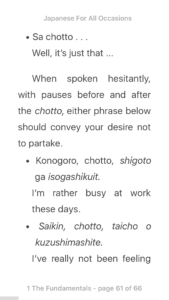
In this screenshot, what they have as “isogashikuit“ should be “isogashikute.” Anyone who is familiar with Japanese phonetics would know that the former is not possible to pronounce in Japanese. This would be rather confusing to a beginner.
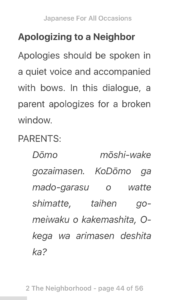
In this picture, the error isn’t nearly as egregious, but it’s there. The word for “child” in Japanese is “kodomo,” but they have it as “KoDōmo,” which, in addition to the strange capitalization of the “d,” indicates a long “o” sound in Japanese, which is incorrect for this word.
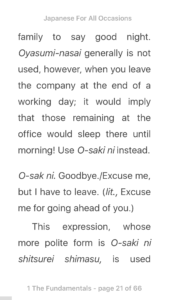
The error in this image is pretty minor. In one instance it says “O-sak ni,” which is missing the final “i” in the phrase “O-saki ni.” Still, it could confuse a beginner.
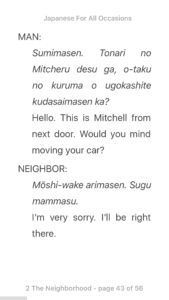
The error in this image may be due to the Japanese proofreader’s unfamiliarity with English letters, since in romaji (writing Japanese with English letters) “mammasu” looks similar to the correct “mairimasu.” This is especially so with the font and italics in this book.

This is a minor error with just one letter wrong since instead of “Tukkuri” it should be “Yukkuri,” but again, if you’re a beginner, you’d learn the wrong word and communication with Japanese people would be impeded. Not what you want from a book on foreign language learning.

Another minor error here. This one is only an extra space in the word “Iie,” but again, confusing to a beginner.
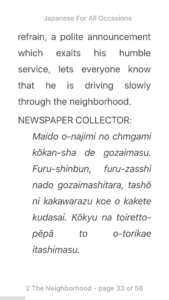
Here’s another example where the font and relative unfamiliarity with writing Japanese in romaji may have tripped them up. The word “chmgami” is not possible in Japanese phonetics, and it should instead say “chirigami.”
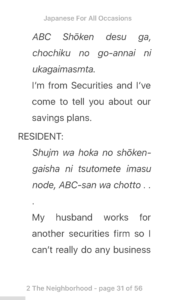
This one has two typos, both of which form words that are impossible pronunciations in Japanese. The first is that the word “ukagaimasmta” should be “ukagaimashita.” The second is “Shujm,” which should be “Shujin.”
So that’s what I’ve found in this book so far. Again, rather disappointing to see so many Japanese errors in a book that teaches Japanese. The actual content seems beneficial, but the proofreading needs some help. If I were a beginner I’d either be confused about the Japanese sound system or I’d be learning some incorrect Japanese. I’m sure that’s not the author’s intention.
I didn’t get these wrong, did I? I wasn’t wearing my glasses but these typos jumped out at me.